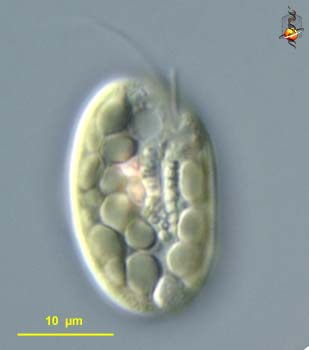Cryptomonas: Difference between revisions
| Line 13: | Line 13: | ||
==Description and Significance== | ==Description and Significance== | ||
Cryptomonas ovata is a species of phytoplankton that is common in freshwater systems around the world. The species | Cryptomonas ovata is a species of phytoplankton that is common in freshwater systems around the world. The species can be defined as "cryptomonads", which is a group of biflagellate organisms that includes both protozoans (order Cryptomonadida) or alga (class Cryptophyceae), this species belonging to the latter. C. ovata functions as a primary producer in freshwater ecosystems and contributes to the foraging base of many heterotrophs, including macroinvertibrates and fishes. | ||
==Genome Structure== | ==Genome Structure== | ||
Revision as of 00:38, 21 April 2010

Classification
Eukaryota; Cryptophyta; Cryptomonadales; Cryptomonadaceae; Cryptomonas
Species
|
NCBI: [1] |
Cryptomonas Ovata
Description and Significance
Cryptomonas ovata is a species of phytoplankton that is common in freshwater systems around the world. The species can be defined as "cryptomonads", which is a group of biflagellate organisms that includes both protozoans (order Cryptomonadida) or alga (class Cryptophyceae), this species belonging to the latter. C. ovata functions as a primary producer in freshwater ecosystems and contributes to the foraging base of many heterotrophs, including macroinvertibrates and fishes.
Genome Structure
Describe the size and content of the genome. How many chromosomes? Circular or linear? Other interesting features? What is known about its sequence?
Cell Structure, Metabolism and Life Cycle
Interesting features of cell structure; how it gains energy; what important molecules it produces.
Ecology and Pathogenesis
Habitat; symbiosis; biogeochemical significance; contributions to environment.
If relevant, how does this organism cause disease? Human, animal, plant hosts? Virulence factors, as well as patient symptoms.
References
Author
Page authored by Alison Cutter and Alexandra David, students of Prof. Jay Lennon at Michigan State University.
